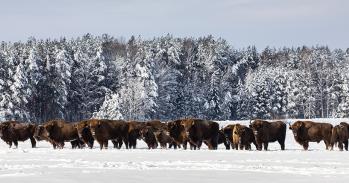
Assigning an economic value to the benefits which nature provides might not always promote the conservation of biodiversity, and in some cases may lead to species loss and conflict, argues a University of Cambridge researcher.
Assigning an economic value to the benefits which nature provides might not always promote the conservation of biodiversity, and in some cases may lead to species loss and conflict, argues a University of Cambridge researcher.
There is a risk that traditional conservation strategies oriented toward biodiversity may not be effective at protecting the economic benefits of an ecosystem, and vice-versa
Bill Adams
Putting a price on the services which a particular ecosystem provides may encourage the adoption of greener policies, but it may come at the price of biodiversity conservation. Writing today (30 October) in the journal Science, Professor Bill Adams of the University’s Department of Geography argues that assigning a quantitative value to nature does not automatically lead to the conservation of biodiversity, and may in fact contribute to species loss and conflict.
While assigning a monetary value to the benefits of an ecosystem can be an essential tool in the environmental planning process, unequal access to those benefits, particularly where there are differences in wealth and power, can lead to poor trade-offs being made, both for the ecosystem itself and those who rely on it.
“Putting a price on what nature provides is not in itself a conservation measure,” said Adams. “There is a risk that traditional conservation strategies oriented toward biodiversity may not be effective at protecting the economic benefits of an ecosystem, and vice-versa.”
For example, when stream channels in the US state of Maryland were re-engineered to provide a means of natural flood control, it ended up causing the loss of trees which had been growing next to the water and were unable to adapt to their new, drier environment.
The ways in which we depend on our natural environment are increasingly expressed as ‘ecosystem services’, or the range of benefits we get from nature for free. These benefits include the provision of food and clean water, erosion control and carbon storage. Quantifying the value of nature in this way is meant to allow policymakers to consider the potential economic and social impacts of altering a particular habitat.
This approach does sometimes lead to win-win scenarios, where the value of ecosystem services is dependent upon a high level of biodiversity. One example is in the coffee plantations of Costa Rica, where the retention of forest habitat in areas around the plantations doubled the amount of pest control of coffee berry borer beetle provided by birds, which benefitted the coffee farmers while protecting biodiversity.
However, consideration of ecosystem services when making decisions does not automatically lead to retention of biodiversity. “In many cases, trade-offs are made,” said Adams.
Several factors cause tension between biodiversity conservation and ecosystem services. One problem is that the biological and physical processes that guarantee the supply of specific ecosystem services may be different from those that support valued species. An ecosystem that is managed to deliver particular services may not support particular elements of biodiversity.
A second problem is that there are often no markets for some vital services, such as soil formation and nutrient cycling, and while payment schemes can be created to create market-like structures, the value assigned to ecosystem services depends on market prices, which are subject to change.
A third problem arises from the institutional and political processes linking economic benefits from ecosystems and human wellbeing. “Unequal access to benefits, for example where there are differences in wealth and power among stakeholders, can lead to trade-offs being made, with negative impacts for the ecosystem itself and those who rely on it,” Adams comments “It’s not enough to identify the net benefits of ecosystem services; it also matters who gets them.”
For example, in Nepal, research has shown that forests managed by the local community, rather than by the state, yielded benefits of clean water, tourism and harvested wild goods. However, these forests restricted poorer people’s access to forest-derived products, creating hardship, illegal use and impacts on other areas.
“In a world run according to economic arguments, the survival of biotic diversity will depend on its price,” said Adams. “Sometimes economics will favour conservation and sometimes it won’t. But conservationists need to plan for both outcomes.”
The text in this work is licensed under a Creative Commons Licence. If you use this content on your site please link back to this page. For image rights, please see the credits associated with each individual image.





